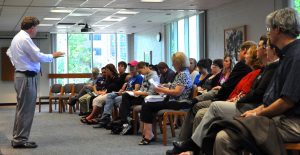
BARTHOLOME RONDET
Hannah Jones/Winonan
Mackenzie Haugen, like so many other college students, is in thousands of dollars of debt.
She was one of the twenty or thirty students sitting amidst faculty and board members from Winona State University, as well as some surrounding schools at last week’s Charting the Future forum on Thursday.
That group of twenty or thirty was mostly a class of students who had been required by their professor to attend.
Besides Haugen, none of them spoke.
Haugen is the Student Senate representative for the College of Business and a transfer student. With her student loans maxed out, she believes she will be forced to choose her first job with her financial situation weighing heavily on her mind.
That future is a reality she and many others face every day.
“It’s a little bit concerning to me that there wasn’t more of a student presence,” she said. “We need to make our voices heard.”
With economic pressures rising, Haugen said that she sees a future generation who will not be able to attend college at all. She came to the forum to represent members of that generation, as well of members of her own who struggle to pay off their loans.
The forum was held to provide feedback on a drafted initiative by the Minnesota State Colleges and Universities System (MnSCU). Chancellor Steven J. Rosenstone selected Winona State’s President Scott Olson to be on a focus group for the project back in 2012. Olson said the focus groups met within a cloistered “cone of silence,” deliberating strategic priorities for Minnesota’s colleges and universities and emerging with a draft report from the conclusions reached during the workshops.
The report was distributed back to the schools to be reviewed by students and faculty so they could provide feedback. Haugen was surprised by how little it said about helping students pay for school.
“I have so many loans that it gives me anxiety to even think about paying them off,” Haugen said in the meeting. “I think the draft needs an additional category on affordability.” Haugen called for a streamlined, more efficient MnSCU to cut expenses and give the money back to students.
Haugen soon found that she wasn’t the only person in the room with concerns.
Representative Gene Pelowski of the Minnesota House of Representatives raised his hand and rose to his feet.
“Who wrote this?” he asked Olson. “Your name is at the top, but who wrote it?”
Pelowski said he was concerned about who was really doing the talking in terms of the reform. He and the Minnesota legislature had just worked extensively to increase Minnesota’s college education budget by $250 million and impose a two-year freeze on tuition in June. He said he failed to see how the draft reflected the consequences of the legislation—or the real world in general, having been “written in the bowels of MnSCU.”
“We [the legislature] have charted a future. We have charted it at great cost,” he said, brandishing his copy of the draft. “If you’re charting a future that’s different than the legislature’s, I want to know why.”
Olson said that the document didn’t address the same reforms the legislature had passed, but rather posed “different questions.” He answered questions as they cropped up from all sides of the room, having the points recorded on two easels at the front of the room. The draft, after all, was not necessarily his point of view. He said that the education system office could stand to be a bit more efficient, and a bit more effective.
“If this gets thrown in the trash,” he said, holding his copy of the draft, “I don’t care.” His job, he said, was merely to make sure every voice was heard. Originally, he had planned to make it through six major points in the draft in the allotted 90 minutes for the forum. Due to argument and discussion, however, they only managed to cover half of them that day.
Haugen said she wasn’t as suspicious of the process described in the draft as Pelowski. She saw it more as a visionary document rather than a concrete plan.
“This is a really good start to a vision from MnSCU,” she said. She hesitated, looking around. The class of students had left long ago, about halfway through the presentation. “Still,” she said, “I guess it doesn’t really reflect reality to the degree that it could.”
Olson said that encouraged students to give feedback on the draft online, even if they didn’t attend the forum. In October, the focus groups will reconvene and discuss the data they’d collected from the forums for possible revisions. Then, in November, the draft will be submitted to the MnSCU trustees. Haugen said she wanted more student bodies at the forums themselves, packing into buses to attend rallies at the capital and sending emails to their representatives.
“Our opinions really do matter,” she said.
Contact Hannah at [email protected]




























































